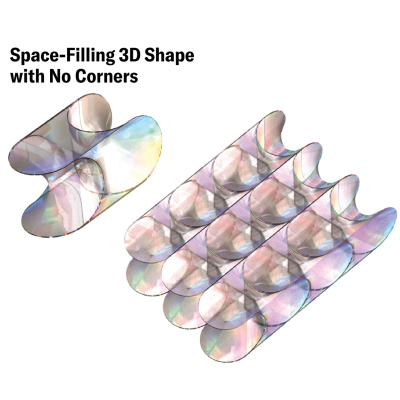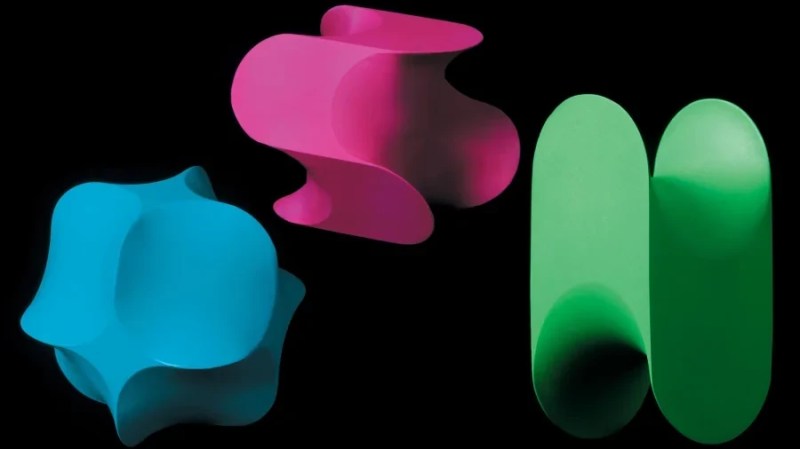Tiling a space with a repeated pattern that has no gaps or overlaps (a structure known as a tessellation) is what led mathematician [Gábor Domokos] to ponder a question: how few corners can a shape have and still fully tile a space? In a 2D the answer is two, and a 3D space can be tiled in shapes that have no corners at all, called soft cells.
 These shapes can be made in a few different ways, and some are shown here. While they may have sharp edges there are no corners, or points where two or more line segments meet. Shapes capable of tiling a 2D space need a minimum of two corners, but in 3D the rules are different.
These shapes can be made in a few different ways, and some are shown here. While they may have sharp edges there are no corners, or points where two or more line segments meet. Shapes capable of tiling a 2D space need a minimum of two corners, but in 3D the rules are different.
A great example of a natural soft cell is found in the chambers of a nautilus shell, but this turned out to be far from obvious. A cross-section of a nautilus shell shows a cell structure with obvious corners, but it turns out that’s just an artifact of looking at a 2D slice. When viewed in full 3D — which the team could do thanks to a micro CT scan available online — there are no visible corners in the structure. Once they knew what to look for, it was clear that soft cells are present in a variety of natural forms in our world.
[Domokos] not only seeks a better mathematical understanding of these shapes that seem common in our natural world but also wonders how they might relate to aperiodicity, or the ability of a shape to tile a space without making a repeating pattern. Penrose Tiles are probably the most common example.

















Nautiluses don’t know how to make corners.
Tainted Math!
Sometimes I feel I want to, bum bum,Tessellate…
Wordplay. Maybe not “corners”, but edges, and the edges are continuous deformations of what were once corners.
It’s not wordplay, it’s math. Sharp corners have different derivatives in all dimensions compared to edges: with an edge, there’s a path you can take that has a smooth derivative, with a corner, there is none.
I haven’t seen “corners” mentioned in 3D math, it is always about vertices and edges. And space filling tiling shapes without vertices are pretty nifty. And removes the ambugitidy of “corners”
If you look at the article, it’s not just vertices, it also includes cases where you form a cusp in 2D. I can’t think offhand how you’d define it (and can’t read the paper at the moment), but it’s going to be similar to a smooth derivative.
Jeez, found it 2 seconds later. It’s s corner if no smooth curve on the boundary contains that point. So 2 faces bent into a cusp are a corner because there’s no curve including those points (only a line).
It might also have physical implications, e.g. in terms of whether these shapes will pack themselves optimally under compression. If there is a differentiable curve through every point on the boundary, then there’s no way for any number of shapes to touch where they can’t slide against each other. Though I’m sure there’s more to it than that.
Corners are infamous weak points in many situations… so are edges but perhaps not as much. Sometimes in mathematics the theory comes a long time before you figure out the application, which is part of the fun :)
Maybe would have been more descriptive to use “vertices,” spots where several edges meet
Whoops didn’t read the thread award, my bad
Pringles solved this long ago
IDK, been printing gyroid infill for a while, not a lot of corners there….
gyroid definitely fills space ;-)
If you define a finite, three-dimensional unit cell that can be assembled into gyroid infill, the shape within that cell may have corners (where you cut through the infill pattern).
But more to the point, it doesn’t fill space (the point of infill being to fill as little space / use as little material as possible)…
One of my students has a Scientific American subscription and brought this article to class this week. It’s so amazing to see just how engrossing topology is for many students that would otherwise not engage with other mathematics. A vigorous and cheerful discussion regarding the nature of an edge and how to best color these shapes is still ongoing with every single student throwing in at least a few ideas.
I am convinced that nearly all enthusiasm and talent for math comes from the ability to think about concepts visually. Some forms of math are easier to visualize than others
Edges are pretty much the 3D equivalent of 2D corners, though.